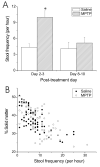Loss of enteric dopaminergic neurons and associated changes in colon motility in an MPTP mouse model of Parkinson's disease
- PMID: 17586496
- PMCID: PMC2277100
- DOI: 10.1016/j.expneurol.2007.05.010
Loss of enteric dopaminergic neurons and associated changes in colon motility in an MPTP mouse model of Parkinson's disease
Abstract
Gastrointestinal (GI) dysfunction is the most common non-motor symptom of Parkinson's disease (PD). Symptoms of GI dysmotility include early satiety and nausea from delayed gastric emptying, bloating from poor small bowel coordination, and constipation and defecatory dysfunction from impaired colonic transit. Understanding the pathophysiology and treatment of these symptoms in PD patients has been hampered by the lack of investigation into GI symptoms and pathology in PD animal models. We report that the prototypical parkinsonian neurotoxin, MPTP (1-methyl 4-phenyl 1,2,3,6-tetrahydropyridine), is a selective dopamine neuron toxin in the enteric nervous system (ENS). When examined 10 days after treatment, there was a 40% reduction of dopamine neurons in the ENS of C57Bl/6 mice administered MPTP (60 mg/kg). There were no differences in the density of cholinergic or nitric oxide neurons. Electrophysiological recording of neural-mediated muscle contraction in isolated colon from MPTP-treated animals confirmed a relaxation defect associated with dopaminergic degeneration. Behaviorally, MPTP induced a transient increase in colon motility, but no changes in gastric emptying or small intestine transit. These results provide the first comprehensive assessment of gastrointestinal pathophysiology in an animal model of PD. They provide insight into the impact of dopaminergic dysfunction on gastrointestinal motility and a benchmark for assessment of other PD model systems.
Figures






Comment in
-
The role of MPTP in Parkinson's disease: connecting brain and gut?Exp Neurol. 2008 Apr;210(2):281-5. doi: 10.1016/j.expneurol.2008.01.004. Epub 2008 Jan 19. Exp Neurol. 2008. PMID: 18279853 Review. No abstract available.
References
-
- Abbott RD, Petrovitch H, White LR, Masaki KH, Tanner CM, Curb JD, Grandinetti A, Blanchette PL, Popper JS, Ross GW. Frequency of bowel movements and the future risk of Parkinson's disease. Neurology. 2001;57:456–462. - PubMed
-
- Ashraf W, Wszolek ZK, Pfeiffer RF, Normand M, Maurer K, Srb F, Edwards LL, Quigley EM. Anorectal function in fluctuating (on-off) Parkinson's disease: evaluation by combined anorectal manometry and electromyography. Mov Disord. 1995;10:650–657. - PubMed
-
- Betarbet R, Canet-Aviles RM, Sherer TB, Mastroberardino PG, McLendon C, Kim JH, Lund S, Na HM, Taylor G, Bence NF, Kopito R, Seo BB, Yagi T, Yagi A, Klinefelter G, Cookson MR, Greenamyre JT. Intersecting pathways to neurodegeneration in Parkinson's disease: effects of the pesticide rotenone on DJ-1, alpha-synuclein, and the ubiquitin-proteasome system. Neurobiol Dis. 2006;22:404–420. - PubMed
Publication types
MeSH terms
Substances
Grants and funding
LinkOut - more resources
Full Text Sources
Other Literature Sources

